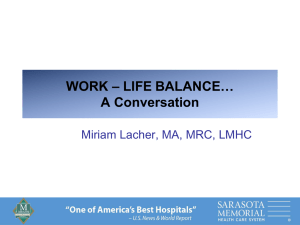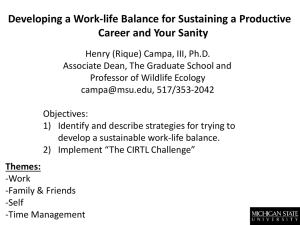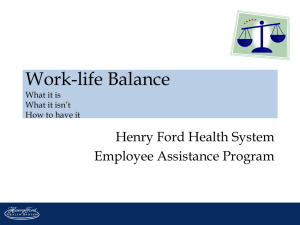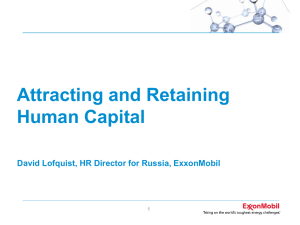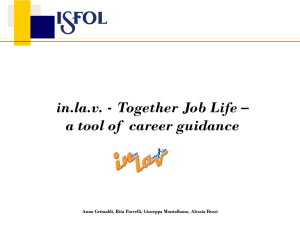Work-Life Balance - Towards a New Politics of Work and Time
advertisement
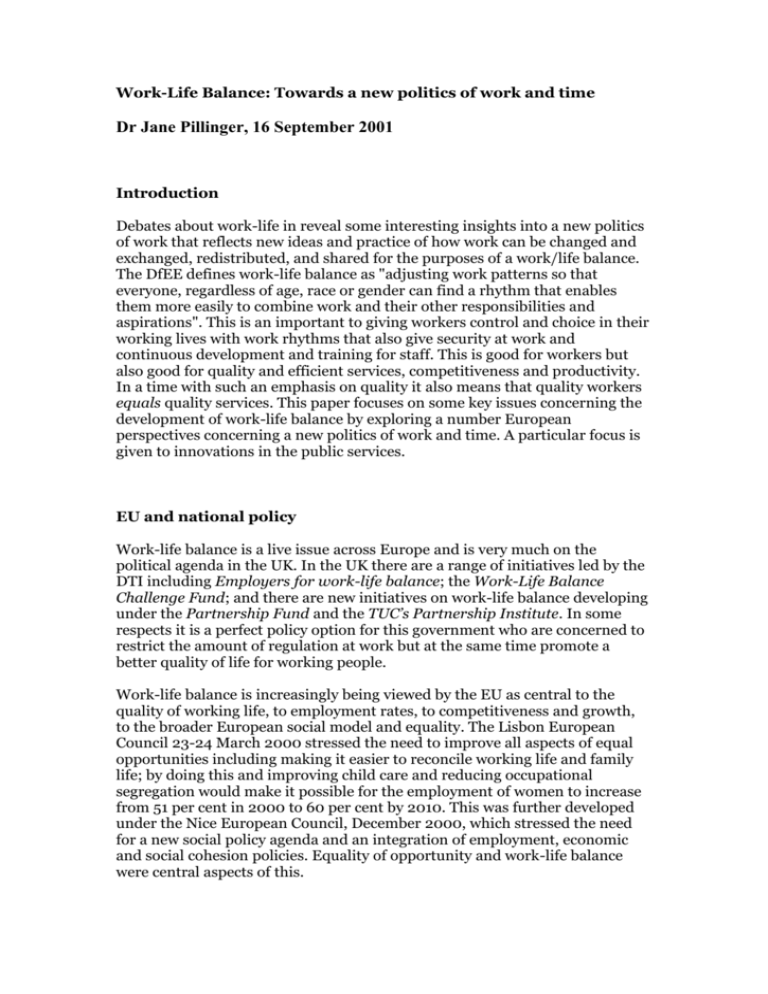
Work-Life Balance: Towards a new politics of work and time Dr Jane Pillinger, 16 September 2001 Introduction Debates about work-life in reveal some interesting insights into a new politics of work that reflects new ideas and practice of how work can be changed and exchanged, redistributed, and shared for the purposes of a work/life balance. The DfEE defines work-life balance as "adjusting work patterns so that everyone, regardless of age, race or gender can find a rhythm that enables them more easily to combine work and their other responsibilities and aspirations". This is an important to giving workers control and choice in their working lives with work rhythms that also give security at work and continuous development and training for staff. This is good for workers but also good for quality and efficient services, competitiveness and productivity. In a time with such an emphasis on quality it also means that quality workers equals quality services. This paper focuses on some key issues concerning the development of work-life balance by exploring a number European perspectives concerning a new politics of work and time. A particular focus is given to innovations in the public services. EU and national policy Work-life balance is a live issue across Europe and is very much on the political agenda in the UK. In the UK there are a range of initiatives led by the DTI including Employers for work-life balance; the Work-Life Balance Challenge Fund; and there are new initiatives on work-life balance developing under the Partnership Fund and the TUC’s Partnership Institute. In some respects it is a perfect policy option for this government who are concerned to restrict the amount of regulation at work but at the same time promote a better quality of life for working people. Work-life balance is increasingly being viewed by the EU as central to the quality of working life, to employment rates, to competitiveness and growth, to the broader European social model and equality. The Lisbon European Council 23-24 March 2000 stressed the need to improve all aspects of equal opportunities including making it easier to reconcile working life and family life; by doing this and improving child care and reducing occupational segregation would make it possible for the employment of women to increase from 51 per cent in 2000 to 60 per cent by 2010. This was further developed under the Nice European Council, December 2000, which stressed the need for a new social policy agenda and an integration of employment, economic and social cohesion policies. Equality of opportunity and work-life balance were central aspects of this. Reconciling work and family life has been an objective of key European policies, including the European Employment Strategy from the start and the 2001 Employment Guidelines stress the need for a greater equality of opportunity and policies which favour the family to be developed and promoted by the member states and the social partners. On 29 June 2000 the Council adopted a Resolution on the balanced participation of women and men in family life. Nine qualitative and quantitative indicators were developed concerning the relationship between working life and family life were drawn up under the French Presidency covering paid and unpaid employment, parental leave, childcare, integrated policies, dependent older people, opening times of public services and shops, time spent in work, care, domestic work etc. The European Strategy Against Social Exclusion stresses the need to develop national strategies on social inclusion through national action plans. One aspect of the need to improve the entry of women and other groups who are excluded from the labour market is the development of family friendly policies. Work organisation and working time have been subjects of a great deal of attention in recent years. Under both the Working Time Directive and the Green Paper on Work Organisation the introduction of agreements on family friendly and flexible working practices are viewed as an essential component of the need to combine the security that employees need with the flexibility that employers need. Finally, the directives on equal pay and equal treatment have stressed the need for the reconciliation of work and family life as an essential route to equality between women and men. This is also an important element of the Fifth action programme on equality between women and men (2001-2004). Linking work-life balance to positive flexibility There are many ways in which effective practices to promote work-life balance have been introduced to the benefit or employers and employees alike and of good practice and innovative approaches to flexible working time have been developed in recent years. Work-life balance is about improving the quality of working life, including flexible working time, lifelong learning and family friendly policies. This is increasingly seen as a trade-off whereby productivity gains depend on flexible, innovative working practices. Traditionally greater flexibility and improvements to working conditions have been seen as being in conflict but this is not necessarily the case. There is plenty of evidence to show that companies that negotiate innovative work practices that also benefit staff are forward looking, competitive and profitable (TUC, 1998; TUC 2001). According to the TUC work-life balance is central to the introduction of positive flexibility in the organisation of work. The Tayloristic model of production, with work organised around a full-time, five day a week, male model of continuous employment is no longer the norm; increasingly work becoming more precarious. The increase in flexible work, globalisation and an increase in service sector employment has production organised to time-match the demand for products and a corresponding increase in insecure flexible work, particularly of women's part-time work in the expanding service sector of the economy. On the plus side the development of new approaches to working time and innovative approaches to flexibility and work-life balance are taking foot across Europe, particularly in the public services. Thinking about time over the lifecourse It is interesting to explore the organisation of time in relation to key developments in our work and personal lives throughout working life in the context of what is a new politics of work and time. This reflects new ideas and practice of how work can be changed and exchanged, redistributed, and shared for the purposes of a work-life balance over the lifecourse. It also engages us in a new way of looking at how time affects different groups of people in different ways, and how time resources are used differently by different groups and at different stages in the lifecourse. Thus how we use personal time and the value associated with personal time can affect our capacities to participate in social, economic/work or political time. This raises a number of inter-related questions. How we can focus on lifecourse experiences, needs, risks and opportunities within a framework of lifetime hours? How can different needs, aspirations, wants and interests over the lifecourse be reconciled with working life? How can the quality of working life be linked into the quality of life generally and visa versa? What does this mean for the ways in which we attached value to how we use our time: work time, economic time, personal time, social time, political/community participation time and other time resources? How can issues of employer led flexibility for extended service opening times be reconciled with choice in working hours and quality of life for different groups of people and at different stages in the lifecycle? This means that we need to look at the issues of time in a variety of ways. This includes opportunities to explore a range of frameworks e.g. a work-life balance that enables parents (men and women) to reconcile their work with their family life, that enables women to participate in the labour market, that allows workers to take leave from the labour market so that they can participate in education or training or to take up an interest, hobby or leisure pursuit that interests them, so that workers can also play roles in their local communities and in politics. It might mean that workers can reorganise their working lives so that reorganise their working hours around shorter days, weeks, months or years. It may also make it possible for the labour market to be organised so that it can take account of the different needs, for instance, of younger workers, older workers, disabled workers, women workers etc (most of whom do not fit into the traditional male model of continuous, full-time work). In line with this thinking a number of debates amongst trade unions at the European level have seized on the idea of lifetime working hours on the basis that we could all work a similar number of hours over our working lives, but that these can be increased or decreased according to different demands, needs, risks or opportunities as they arise over our working lives. We may choose to reduce our working hours at certain times, for example, for childcare or for partial retirement; or we may seek to take extended leave for other reasons, for example, for education or training. The politics of time ‘Time’ as a concept offers us an interesting framework to discuss some of these lifecourse issues. It also gives us an opportunity show the importance of the centrality of time for reorganising work to take account of the different and diverse needs of different workers and at different stages in their lives; or alternatively how those groups who are outside of the labour market are being encouraged to enter the labour market through activation measures. Alternatively we can start from the other way around: how can the quality of life be enhanced, how can people’s diverse needs and demands over the lifecourse, their personal, care or other needs and responsibilities fit into work. It can also be useful to help us do things differently: how we reorganise our workplaces, our local services, our cities; thereby linking time issues to how services are organised to fit into people’s diverse and complex needs. The politics of time also alerts us to new possibilities for understanding the complex relationships that women have with the paid labour market on the one hand, and to care demands and responsibilities on the other hand. In making the labour market open to women then there is a need for a parallel process of the change and exchange of social and economic power between women and men to take place. The overlaps between the politics of time and gender equality could be seen from a number of initiatives where women have identified the key issues for collective bargaining as being flexible working time. In most cases it was work/life balance and family friendly working hours that was at the top of the list of priorities identified by women in the trade unions. Gender is central to an analysis of time particularly because women’s time falls outside of the time systems that operate in the paid workplace. Women often have to give time as carers; their work whether it be paid or unpaid is frequently time-consuming and time-precious. As a result policies that aim to reconcile family and work life and to mainstream equality into public life are central to working time, in the recognition that work needs to be organised within different time-frames for women. In this respect some experiments in making working time more flexible, have had the consequence of legitimising women's exit from the labour market, and, therefore, further undermining women's position in the labour market. For example, working time experiments in Finnish municipalities and health services to introduce a six hour day, part-time pensions, part-time benefits and work rotation, the bulk of which have been taken up by women, have had this negative consequence associated with them. As a result, in a growing number of countries, and particularly in the Netherlands, the collective reduction and reorganisation of working time has become strategically important to achieving equality and the sharing of work and family life. These issues are broader than equality of opportunity and family friendly issues; in many respects gender equality runs through all of the issues of the reorganisation of time and are equally applicable to men as they are to women. We can see therefore that the politics of time is about a number of key issues – time to care; time to learn; time to have time; time for ourselves; time out of the labour market etc. New thinking and practice about time and experiments in working time that link policy objectives, for instance, of equal opportunities, or educational leave, service quality or of job creation, are significant levers in the making and shaping of both future labour markets across Europe. In some cases there are ways in which employees (particularly women's) choices about working time have become increasingly possible in this new climate of flexibility, whereby flexible working times, as distinct from flexible work, allow for more choice and expressions of time preferences. Working time preferences can be severely constrained by inadequate state support services, for instance, for child or elder care, which in turn affect women's participation in either full or part-time work to different degrees in different European countries. They are also affected by the extent to which flexibility is negative (driven by employers to meet competitive demands and with limited recognition of worker or trade union participation) and positive forms of flexibility to aim to create the win-win situation. Changes in work organisation and working time alongside new forms of flexibility at work in the public services have linked local service improvements to user needs; the result has been some highly innovatory experiments in local areas, in municipalities and in the case of Italy in particular, across whole cities. These initiatives place new values on time and the restructuring of services to meet user needs, to respond to citizen’s demands, and also assist in the work/life balance, care and other needs. Time is a tool for understanding new values based on the idea that the quality of time is a prerequisite of changing social and economic relations. As a result time is critical to women’s and men’s working time preferences, to strategies to redistribute working time to allow for family friendly working practices, to equal opportunities, and to informal care. It can also result in new ideas about the redistribution of work (and therefore of time) between the employed people (who experience time deficits and time pressures) and unemployed people (who often have a surfeit of time). At another level time is a resource and a commodity. It is a central component of modern industrial societies and whatever the analysis, time has become a precious resource and making the best use of time is as integral to work organisation as it is to family and caring responsibilities. The question is how can we conceptualise time so that it can be used as a lever for changing social and economic relations? Is the organisation of time fixed – if not how can it be changed? Despite many of the negative experiences of flexible work across Europe, enlightened thinking on the future of work and a growing awareness of the importance of time to these debates, means that a new space has opened up for work to be more closely connected to new arrangements that allow for work-life balance away from rigid patterns of employment, towards more positive forms of flexibility. The case for work-life balance It is worth stepping back to look at the case for work-life balance, which has gained importance as a tool for equality, business development, employment, educational development and social development across Europe: The equality case: to enable parents (men and women) to reconcile their work with family life. Without attention to equality and a flexible way of organising work employers will loose out on many talented groups – especially women – who are excluded from making a valuable contribution. The business case: employers are increasingly considering helping their employees to achieve a better work-life balance. Expectations about the quality of working life have changed and those employers that can meet those expectations are more likely to have improved productivity, retention, recruitment and commitment to their organisation’s goals. Evidence shows that those companies that have been flexible in allowing for a work-life balance have an improved company profile, have developed new business opportunities, have recruited from a wider pool, have been better equipped to recruit and retain staff, whilst also improving staff morale, health, and productivity, and reducing absenteeism and staff turnover. In some cases it has enabled companies to have longer opening hours. The employment case: attracting and retaining staff, especially enabling women or other groups to enter the labour market at a time when employers are experiencing skills and staffing shortages. The educational case: enabling workers to take leave from the labour market so that they can participate in education and training and thereby ensure that skills are updated and learning and innovation becomes embedded into organisational culture. The social case: to enable workers to take up an interest, hobby or leisure pursuit or play roles in their local communities or local politics, and to contribute to social inclusion and social cohesion. The service quality case: improving service quality whether this be at the level of an individual service, a whole municipality, or even a whole city is closely tied to the need for flexible working hours that allow for more flexible and extended service provision, whilst flexible working time and trade-offs for reduced working time can create a win-win in the service quality equation. In essence this is about ensuring that the workplace culture meets the changing workforce. This perspective is leading to the de-valuing of the long hours culture and presenteeism, with an increasing emphasis on the quality of life or a balanced lifestyle and on the need to retain staff who have been recruited, trained and rewarded. This means valuing performance rather than the number of hours worked, or to put it another way to shift the emphasis from inputs to outputs. The baseline survey carried out by the Department for Education and Employment as part of the government’s work-life balance initiative found that 91 per cent of those responding felt that "people work their best when they can balance their work and other aspects of their lives". Nearly three quarters of employers believed that work-life policies fostered good employment relations and over half identified improvements to motivation and commitment. The survey found that everyone, not just parents, want to get a life and better balance the demands of home and work life through flexible working practices. It is equally the case that many men would like to work shorter hours and have more flexibility in the way that they work. Changing work in the public services Research on working conditions shows us that the intensity and pace of work has increased dramatically in recent years. Levels of stress and ill-health are on the increase. Recent research on the social public services covering all fifteen member states found that many of the key findings regarding the improvement of both living and working conditions related to work/life balance issues, whether the be related to the need to develop staff training and competencies as the skills required to provide services become more complex, or issues of how work in the social public services can be organised to take account of care and other needs for time outside of work (Pillinger, 2001). In summary the research found high levels of stress, work pressure, low status and low pay; staff feel valued if they are involved in decision making and have some choice over their working time; links between the quality of services and the quality of working life; those employers that invested in their staff, that had introduced more participatory styles of management were also those that offered the best quality of service and the best working conditions. There are many different examples of work-life balance initiatives across Europe. In summary the different initiatives have developed from a combination of concerns about high levels of unemployment and the need to rotate and create jobs, from the need to develop equal opportunities and family friendly working hours, the competitive need to extend opening times and improve the quality of service to citizens. Strategies to reduce and reorganise working time have been on the agenda of public service unions and some national governments for a decade or more. In some countries this has been related to the opportunities to improve services to users, create new jobs in the social public services and improve the opportunities of working within a framework of negotiated flexibility that allows for more choice and autonomy in working time. Initiatives to introduce more flexible working time arrangements have had a positive effect in this regard in allowing for external organisational flexibility, on the one hand, and more internal flexibility regarding working hours, on the other hand (Pillinger, 2000). In a number of countries agreements on working time have enabled reductions in working time to be traded-off against extended service delivery and service restructuring. National agreements in Germany, Sweden, the Netherlands and Luxembourg have prioritised working time reductions and flexible working time as part of this restructuring process and employees are increasingly favouring flexible systems of working time in these countries. In a number of countries, especially Finland, working time reductions are seen within the context of improving conditions of employment, for instance, to reduce work pressure, increase early retirement, leave from the labour market, and holiday time. Furthermore, the trend towards more decentralised local bargaining in the public services is closely tied up with greater flexibility in the labour market. Local and sectoral agreements have become increasingly important to enable adaptations to working time to meet local service needs. Balancing work and family life has become an increasingly important preoccupation of the social partners and of governments at a time when women’s participation in the labour market is growing in all EU member states. In the Netherlands a framework for a care and work law has been developed to find a balance between employment and care. The proposed General Act on Employment and Social Care (AWAZ) aims to equalise the rights of civil servants and other employees, to introduce time saving/banking measures so that additional time worked can be banked and taken as paid leave, and flexibility in working time, including reductions in working time for caring purposes. Workers will have the right to reduce their working hours and work part-time. Funding will also be available for experiments in the better use of time and for research into a new system of paid care leave. In summary these initiatives include: Redistribution of working time between full-time male hours and parttime female hours (Netherlands) Reduced working hours, the 35 hour week and working time solidarity (France) Parental leave and the father’s month in Sweden Part-time work policies (Netherlands and Sweden) and flexible retirement schemes (Germany) Paid leave schemes (Belgium, Finland and Denmark) and unpaid sabbatical schemes (Ireland) Job rotation (Belgium, Finland and Denmark) Flexible working hours: flexi time, job sharing, annualised hours, time banking etc In the UK the DfEE’s baseline survey and other surveys conducted by the TUC and other organizations show that workers want more control over their time and are creating more complex working time schedules. In some cases workers want time rises rather than pay rises. One finding from the DfEE’s survey Work-Life Balance 2000: Results from the Baseline Study was that: There was a substantial demand for flexible working time arrangements from employees. More men wanted flexitime, compressed hours, and annualised hours than women. Women were more likely than men to want term time working or reduced hours. In the UK, flexible working time includes part-time work, V-time working, job sharing, term-time working, compressed working week, working from home, time off in lieu, time accounts, flexible retirement, flexitime, self-rostering, shorter working hours, and annual hours systems. Work-life balance: negotiating a new agenda According to a recent publication of the TUC (2001) work-life balance requires a change in culture about how work is organised including a reorganisation of work, the development of trust, partnership approaches, and joint problem solving. In particular this mean that if changes are to benefits employers and employees alike this may mean that some people have to concede control while others may be asked to take more responsibility in their work. This marks a clear change in the way that industrial relations is organised and the move towards more consensual, joint and partnership working is regarded as a key instrument of the change management process underway in government and in employee-employer relationships. According to the TUC’s latest publication on work-life balance this reorganisation of work includes: commitment to improving the organisation of work by each level of management, from supervisor to chief executive, union representatives and all grades of staff understanding what it means for management, unions and workforce: productivity and profitability, job security, job satisfaction and working time trust which is built by working in partnership to jointly identify and solve problems representation for all groups of staff who will be affected involvement through the widest possible consultation so that staff have the opportunity to contribute to solutions listening to aspirations and expectations considering ideas seriously - recognising that every idea, including the ones you don’t like, need to be examined transparency so that everyone knows what’s going on by keeping staff fully informed testing solutions – it is usually best to test new practices through a voluntary pilot study where staff are able to revert to existing terms and conditions if they wish action on possible solutions rather than shelving the issue until its too late confidence in a positive outcome Bristol City Council: an example of work-life policy The Time of Our Lives project at Bristol City Council is one of the best examples of a work-life balance project particularly because of the process through which change was implemented. The project was run by the TUC, Local Government Management Board, Bristol City Council and council trade unions in order develop for innovative working patterns that were also linked into improving the quality of Council services alongside employees’ choices for work-life balance. This was based on the development of a partnership to achieve the optimum ways to organise work and time within the context of a positive model of flexibility. The project had significant political and management leadership and trade union support (GMB, TGWU and UNISON) from the start which helped to engender an environment of trust and openness. The project began by surveying staff and focus groups enabled staff to identify the working patterns that would enable them to have a work-life balance, for example, for child care or leisure time. The surveys revealed that a larger number of women than men wanted opportunities for education and training, men were more likely than women to say they wanted more family time, and the most common reason for wanting change was the desire to work more effectively with increased ‘uninterrupted focused’ working time. A pilot was run in the Library Service and despite some initial anxieties expressed by staff Sunday opening has been effectively introduced, resulting in an increase in library use and staff volunteering for Sunday working. Staff feel more in control of their working time through a variety of self-rostering and staff organised shift patterns. As one participant in the project stated: ‘Having the dialogue has been empowering for staff – they know they have an element of control in the workplace. That has had an impact not only on stress and sickness levels but also on productivity – people give more because they are more at ease with the way they work. We have been able to meet the two fundamental principles which underpin the project: to maintain and improve service delivery to the public, whilst meeting staff aspirations for a better work-life balance.’ (Kamaljit Poonia, Equalities Team Leader quoted in TUC booklet, Changing Times, 2001). A vital element in the success of the project has been the process of joint working and the development of a partnership approach. In some cases this may result in a partnership agreement, in others the partnership process may help to facilitate staff ideas and to create management and staff discussions in order to enable innovate and creative responses, develop pilot projects and agree joint solutions. Another example from the Health Service strategy is Working Lives: Programme for Change which has developed a range of initiatives to enable staff to have a work-life balance whilst at the same time giving hospitals more flexibility in organising working time, improving retention and recruitment and providing better patient care. Consultation, communication and involvement of staff is regarded as central to the success of the strategy. For example, Annual Hours schemes are designed to achieve a more even match between supply and demand for staff by distributing staff hours to meet changing levels of need across the year. Conclusion Thinking about work/life balance and the politics of time directs attention to changing values associated with the division of time between work, family and leisure; between women’s and men’s time; and as a result the reorganisation of social and economic life at the individual, family or even city/town level. This brings us into an interesting debate the very nature of ‘time’ and the various and different responsibilities, risks, needs, opportunities and roles that we encounter over the lifecourse. To put it one way: what are the social, personal, economic and political dimensions of how we spend our time. How is social time distinguished from economic or personal time? What implications does this have about how we organise work, care, leisure and participation? The process of change is complex. Fixed patterns of work around time and place are breaking down, new working patterns and flexibility at work are emerging, and the restructuring of the post-war welfare settlement, bound up with market principles, decentralised services and the articulation of user demands and consumer orientations, suggests that a new there are new demands on employers and employees alike. Coupled with raising expectations and greater concerns to promote the quality of life employees are demanding more balance lifestyles. Whilst employers want more workers with more and flexible skills, want to recruit new workers and build business competitiveness and productivity. The experiments to date have shown that it is possible to balance all of these interests and to create a win-win situation all round. TUC (2001) Changing Times TUC (1998) The Time of Our Lives Jane Pillinger (2000) Working Time in Europe: A European Social Dialogue in the Public Services, ETUI: Brussels Jane Pillinger (2001) Quality in Social Public Services, European Foundation for the Improvement of Living and Working Conditions: Dublin Terence Hogarth, Chris Hasluck, and Gaelle Pierre with Mark Winterbotham and David Vivian (2001) Work-Life Balance 2000: Results from the Baseline Study, DfEE
